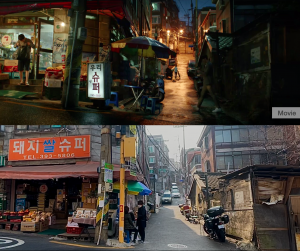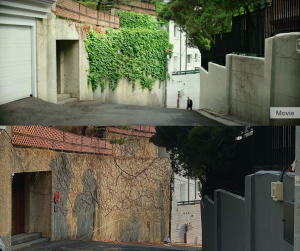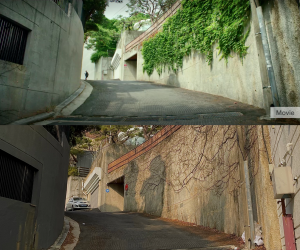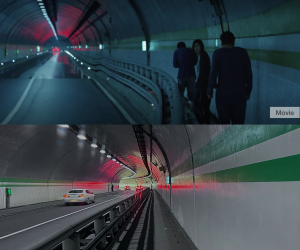PARASITE, DIR. BONG JOON-HO (2019)
Doijissal Supermarket, Seongbuk-dong, Staircase to Jahamun Tunnel, South Korea
Parasite (2019), directed by Bong Joon-ho, is a Korean black comedy film that deals with the conflict between the lower-calls and the upper-class. The Kim family, who lives on the edge of poverty, was spending their whole time folding pizza boxes and stealing wifi from the cafe nearby for their living. They live in a semi-basement flat, which is hugely unsanitary living condition. Whereas, the Park family is the wealthy one, who lives in a luxury house designed by a famed architect. The eldest son of Kims, Ki-woo, with a recommendation of his friend, gets to work as an English tutor for a girl of Parks. Ki-woo soon plans to cheat on Parks and bring all of his family into the Parks house; his sister, mother, and father are now employed as an art therapist, housekeeper, and driver. Thus, the film likened the Kims to ‘parasite,’ tragically and humorously portraying them living parasitically in wealthy ones, Parks.
The house of Kims and Parks are sets that are created for the film, however, there are some real-life shoot locations from the film that well-portrays the contrasting lifestyles of the two families.

Doijissal Sumpermarket: The supermarket where Ki-woo and his friend was drinking; the place where Ki-woo was offered a part-time tutor.
This supermarket is a starting point where the connection is created between Kims and Parks. This scene was filmed at Doijissal Supermarket in Seoul, which symbolizes poverty and the daily life of Kims. When I’ve visited the site, it was a small village that redevelopment has yet to take place. Next to the supermarket, there was an alley with old houses lining up to the end of the hill. In the film, the village was portrayed as a dark and depressing place, but in reality, people were actively working, and a lot of motorcycles and cars were busily passing by a narrow alley.


- Seongbuk-dong: Ki-woo heading to Park’s house for tutor interview
Parks neighborhood is in Seongbuk-dong, which is illustrated as a symbol of wealth in the film. In real-life, Seongbuk-dong is one of the wealthy villages in Korea as many of the political figures and business leaders have begun to live in those luxury houses. It took me through a steep hillside to get to the filming site, and unlike the previous site, the streets were wide and the huge houses with high walls were lined up along the hill, showing a stark contrast to Kim’s neighborhood. In this scene, Ki-woo walks up a hill looking up at high walls, which emphasizes the poor background of Ki-woo, and its realistic difficulties of him reaching the upper-class.


Staircase to Jahamun Tunnel: Kim family running down the long and steep staircase heading to their home in the pouring rain
The scene where Kim’s family running down the long and steep stairs is the most prominent description of the difference in social class between Kims and Parks. The stairs were steeper and the tunnel was longer than I thought, which further highlighted the unapproachable distance between the Kims and Parks.
All three filming sites had stairs in common. The stairs are a meaningful symbol in this film, as it expresses the difference in the hierarchy through the stairs. The Parks house being at a very high place, and the Kims at a very low place, it clearly shows the vertical relationship between the lower and upper-class.
— Seyoung Ho 3035741184
You have made a good attempt at discussing the film representations of the everyday spaces of the Kims and Parks, and have focused in your conclusion, on the use of the stairs as both the literal difference between their residential locations and as metaphors of their social and economic status. You mentioned that the stairs are steeper and the tunnel longer than you had expected. How does the film dramatize their steepness and length/distance? Are there any particular focus on details and in the framing of these stairs that enhance or exaggerate this?
I enjoy your efforts in matching the film shots of the supermarket, the street in Seongbuk-dong and staircase to Jahamun Tunnel, and in pointing out the lighting of these spaces to produce the dramatic effects that the film intended. The film scenes contain darker and bluer tones than your photographs of the actual spaces. Do these create the perception of the spaces and thus their plight/situation being “dark and depressing”? What are your reflections on the stairs as typically a non-place for getting from one place to another (Augé) but in the film has become a space socially produced (de Certeau) by the actions of Kims and Parks in narrating the problem of inequality? A note on the writing: check for typos, grammar (there are a number of sentences missing the determiners “a” and “the”) and syntax.